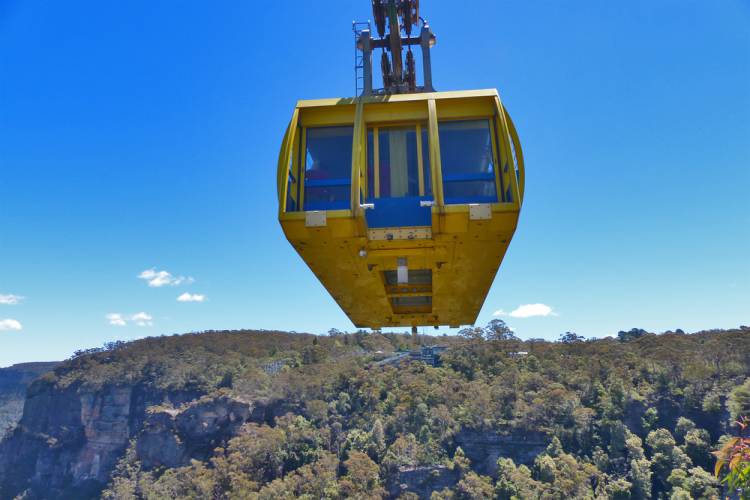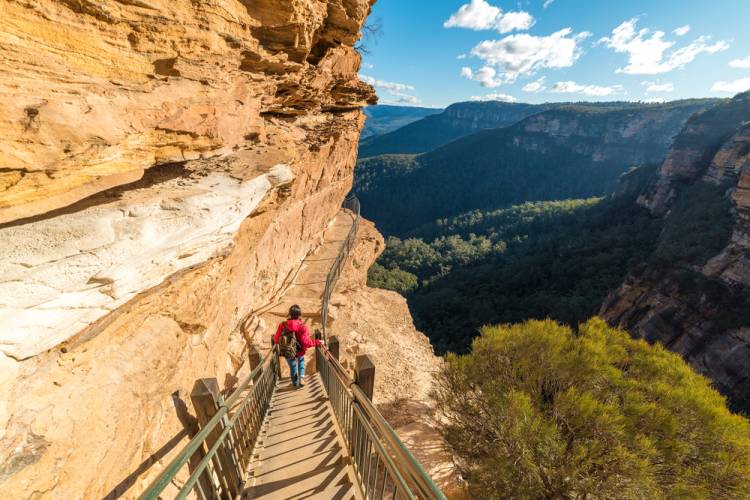In Australia: 0411 288 805 / Outside Australia: +61 411 288 805
- In Australia: 0411 288 805
- Outside Australia: +61 411 288 805
In Australia: 0411 288 805 / Outside Australia: +61 411 288 805
Planning a trip to the Blue Mountains? Wondering what time of year is the best to visit? While there’s never a wrong time, certain months can be more appealing than others. Of course, this all depends on what you’re planning to do, see, and experience.
At OzTrails, we believe that every day is a good day for a trip to the Blue Mountains. However, there are still advantages to visiting in certain months and weeks. This is why we’ve created this article as a guide to the best attractions and reasons to visit throughout different times of the year.
The Blue Mountains offer a plethora of attractions that can be enjoyed year-round. Here are some highlights:
Scenic World: Featuring the Scenic Railway, Scenic Skyway, and Scenic Cableway, it’s a major attraction that offers panoramic views of Jamison Valley and other stunning natural landscapes.
Three Sisters Rock Formation: This iconic formation is a popular lookout and a must-see destination at any time of year.
Lincoln's Rock: The Blue Mountains are renowned for being home to world-famous rock formations, and this is certainly one of the best!
Festivals and Key Events: There are always festivals, events, exhibitions, and experiences available throughout the year. This is what makes this region so exciting, regardless of when you visit.
World-Heritage Listed National Park: The Blue Mountains National Park is a World-Heritage listed site, home to diverse flora and fauna.
Katoomba: The charming town of Katoomba is the gateway to many of the Blue Mountains' attractions.
Only in NSW for a limited time? At OzTrails, we’ve created an incredible Blue Mountains day trip itinerary that allows you to see the best sights and sounds. Book online or contact us for further info!
Average Weather Conditions:
December: 16-27 degrees
January: 17-27 degrees
February: 17-26 degrees
Summer days here are long and sunny, as well as less warm than the more tropical climate of Sydney. This makes it a great destination for outdoor exploration throughout the summer months. Popular activities during this period include bushwalking, picnicking, and visiting the numerous lookouts that offer panoramic and spectacular views of the landscape.
Of course, this period also covers end of year school holidays, making it a great time to round up the kids and bring the whole family along.
Popular Outdoor Activities: Bushwalking, picnicking, and visiting lookouts
Key Events: Blue Mountains Elvis Festival in January
Major Attractions: Scenic World, Three Sisters Rock Formation
With the vibrant atmosphere brought by the influx of tourists, summer also hosts several events and festivals that enhance the overall experience.
Average Weather Conditions:
March: 16-24 degrees
April: 13-21 degrees
May: 10-17 degrees
Autumn is a wonderful time to visit the Blue Mountains, with average temperatures ranging between 10°C and 20°C. The cooler temperatures make it an ideal season for hiking and sightseeing without the intense heat of summer. The pleasant weather allows for the comfortable exploration of the Blue Mountains' natural beauty, with the foliage changing colours and creating a picturesque landscape.
Scenic World: Experience the changing colours of the foliage
Pleasant Weather: Ideal for hiking and sightseeing
Events and Festivals: Soak in the local culture of this fantastic region
When summer comes to a close, the Blue Mountains really come alive with stunning autumnal colours, making it a perfect time for photography and leisurely walks. The mild climate is also ideal for visiting the World-Heritage listed National Park and enjoying the serene environment. Autumn sees fewer tourists compared to the peak summer season, offering a more relaxed and peaceful experience.

Average Weather Conditions:
June: 7-14 degrees
July: 6-13 degrees
August: 7-15 degrees
While the days can be chilly, they are often clear and crisp, providing excellent visibility for enjoying the views. Winter is a great time to visit the Blue Mountains if you prefer more of a quiet and less crowded experience, as the tourist numbers tend to drop during this season.
Cool Temperatures: Clear and crisp days
Warm Jackets: Essential for staying comfortable
Cold Nights: Ideal for enjoying the cosy ambiance of local cafes
Make sure you come prepared with warm jackets and other cold-weather gear to stay comfortable while exploring. The cold nights can be particularly brisk, but this is also the perfect time to enjoy the cosy ambiance of local cafes and restaurants in Katoomba. Winter also offers unique opportunities for experiencing the region's attractions, such as Scenic World, in a different light.
Average Weather Conditions:
September: 9-18 degrees
October: 12-21 degrees
November: 13-23 degrees
There’s no better time to get out into nature than Spring. With less harsh conditions than winter or summer and everything in full bloom, you can never go wrong with a visit between September and November.
Spring is the wettest month in the Blue Mountains, but it also brings the natural beauty of exotic species in bloom. The spring months, with average temperatures ranging between 8°C and 18°C, are ideal for witnessing the vibrant wildflowers and lush greenery that make the Blue Mountains so special. The refreshing and invigorating environment created by spring weather makes it a fantastic season for outdoor activities.
The Spring Season: Ideal for witnessing wildflowers in bloom
Natural Beauty: Vibrant wildflowers and lush greenery
Scenic World: Enjoy fresh, crisp air and spectacular views
The Blue Mountains come alive with colour and life during spring. It's an excellent time to visit Scenic World and enjoy the fresh, crisp air while taking in the spectacular views. Spring is also a popular season for festivals and events, making it a lively and exciting time to explore the area.
The natural beauty of the Blue Mountains is at its peak, offering a feast for the senses and plenty of photo opportunities.
Once you’ve selected a rough date or time of year, the next step is to assess how you’ll get there and plan an itinerary. If you join our award-winning Sydney Blue Mountains Day Tour, everything is handled by our experienced guides with a real passion for the region.
From the heart of Sydney to the Blue Mountain’s deep gorges, steep cliffs, spectacular lookouts, excellent bush walks and wildlife, we’ll take you on an unforgettable ride that you’ll never forget! Our tours are fun, inclusive, affordable, and led by OzTrail’s enthusiastic guides.
If you’re interested in joining our Blue Mountains bus tour, head here to learn more.
Choosing a date is just one of the key considerations that we recommend you take into account. Let’s explore some basics around both accessibility and safety.
Accessible Trails and Facilities: The Blue Mountains offer several trails and facilities designed to accommodate visitors with disabilities. Here are some highlights:
Echo Point Lookout: This iconic lookout offers a stunning view of the Three Sisters and is wheelchair accessible. The nearby Visitor Information Centre also provides accessible amenities.
Scenic World: Features include the Scenic Skyway, Cableway, and Railway, all of which are accessible to visitors with mobility challenges. Scenic World provides disabled parking, ramps, and accessible restrooms.
Leura Cascades: This picnic area and its short, gentle walking paths are suitable for wheelchairs and strollers.
Gordon Falls Reserve: Offers an accessible lookout with panoramic views of the Jamison Valley.
Always check current conditions and accessibility features before visiting, as trail conditions can change.
Stay on Marked Trails: To avoid getting lost or injured, always stick to designated paths and follow trail markers.
Carry Sufficient Water: Dehydration can be a risk, especially during physical activities. Always bring enough water for your hike and avoid relying on natural water sources, which may not be safe to drink.
Check Weather Forecasts: The weather in the Blue Mountains can change rapidly. Always check the forecast before setting out and be prepared for unexpected changes.
Dress in Layers: Winter temperatures in the Blue Mountains can be quite cold, especially in the mornings and evenings. Dress in layers to stay warm and remove layers as needed.
Wear Appropriate Footwear: Trails can be slippery due to frost or occasional snow. Wear sturdy, non-slip footwear.
Shorter Daylight Hours: Days are shorter in winter, so plan your hikes accordingly to avoid being caught out after dark.
Emergency Gear: Carry a fully charged mobile phone, a flashlight, and a basic first-aid kit. Let someone know your plans and expected return time.
Sun Protection: Wear sunscreen, a hat, and sunglasses to protect yourself from the sun. Reapply sunscreen regularly, especially if you are sweating.
Hydrate Frequently: The heat can cause rapid dehydration, so drink water regularly, even if you don’t feel thirsty.
Avoid the Hottest Part of the Day: Plan strenuous activities for early morning or late afternoon to avoid the midday heat.
Wildlife Awareness: Be aware of snakes and other wildlife. Wear long pants and boots to protect against bites, and be cautious around rocks and tall grass.
Bushfire Awareness: Summer can be bushfire season. Stay informed about fire danger ratings and adhere to any park closures or restrictions.
“Our tour guide, Les, was incredibly knowledgeable and experienced. He provided us with a wealth of information about the history of Australia and the Blue Mountains region. I was thoroughly impressed by Les.
As a local, he effortlessly guided us through the Blue Mountains, sharing interesting facts and anecdotes that made the day truly memorable.
I wholeheartedly recommend OZ Trails for an affordable and unforgettable adventure.”
“Excellent Tour..Worth It - One of the best tours to take on a vacation. Time was well managed.Able to visit more places in less time and you get a concession on zoo ticket as well.”
New Tour
